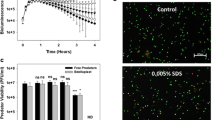Abstract
The effect of organic arsenic compounds and inorganic As(V) and As(III) on Vibrio fischeri luminescence and butyrylcholinesterase activity were evaluated using Microtox and microcalorimetric analysis. Organic arsenic compounds were arsenocholine (AsC), arsenobetaine (AsB), dimethylarsinic acid (DMA), monomethylarsonic acid (MMA) and the antibiotic 4-hydroxy-3-nitrobenzene arsonic acid (HNAA, Roxarsone(R)). HNAA, As(III) and As(V) were found to inhibit Vibrio fischeri light emission whereas MMA, DMA, AsC and AsB produced only a slight effect. By contrast, only AsC, AsB and As(III) were found to inhibit butyrylcholinesterase activity.


Similar content being viewed by others
References
Bednar AJ, Garbarino JR, Ferrer I, Rutherford DW, Wershaw J, Ranville F, Wildeman TR (2003) Photodegradation of roxarsone in poultry litter leachates. Sci Total Environ 302:237–245
Cristensen IV, Ottosen LM, Ribeiro AB, Villumsen A (2005) Electrodialytic removal of Cu, Cr and As from treated wood. In: Lichtfouse E, Schwarzbauer J, Robert D (eds) Environmental chemistry. Green chemistry and pollutants in ecosystems. Springer, Berlin, pp 235–241
Debord J, Verneuil B, Bollinger JC, Merle L, Dantoine T (2006) Flow microcalorimetric study of Butyrylcholinesterase kinetics and inhibition. Anal Biochem 354:299–304
Eguchi N, Kuroda K, Endo G (1997) Metabolites of arsenic induced tetraploids and mitotic arrest in cultured cells. Arch Environ Contam Toxicol 32:141–145
Fulladosa E, Murat JC, Martinez M, Villaescusa I (2004) Effect of pH on arsenate and arsenite toxicity to luminescent bacteria (Vibrio fischeri). Arch Environ Contam Toxicol 46(2):176–183
Gebel TW (2001) Genotoxicity of arsenical compounds. Int J Hyg Environ Health 203:249–262
Golicnik M, Sinko G, Simeon-Rudolf V, Grubic Z, Stojan J (2002) Kinetic model of ethopropazine interaction with horse serum butyrylcholinesterase and its docking into the active site. Arch Biochem Biophys 398:23–31
Hsiung TM, Huang CW (2006) Quantitation of toxic arsenic species and arsenobetaine in Pacific oysters using an off-line process with hydride generation-atomic absorption spectroscopy. J Agric Food Chem 54:2470–2478
Lafferty BJ, Loeppert RH (2005) Methylarsenic adsorption and desorption behavior on iron oxides. Environ Sci Technol 39:2120–2127
Madhavan N, Subramanian V (2006) Factors affecting arsenic concentration in groundwater in West Bengal. Environ Chem Lett 4:79–82
Oya-Ohta Y, Kaise T, Ochi T (1996) Induction of chromosomal aberrations in cultured human fibroblasts by inorganic and organic arsenic compounds and the different roles of glutathione in such induction. Mutat Res 357:123–129
Page JD, Wilson IB (1985) Acetylcholinesterase: inhibition by tetranitromethane and arsenite. Binding of arsenite by tyrosine residues J Biol Chem 260:1475–1478
Ribó JM, Kaiser KL (1987) Photobacterium phosphoreum toxicity bioassay. Test procedures and applications. Toxic Assess: Int Q 2:305–323
Roerdink AR, Aldstadt JH (2005) Sequential injection absorption spectrophotometry using a liquid-core waveguide: Determination of p-arsanilic acid in waters. Anal Chim Acta 539:181–187
Roex EWM, Keijzers R, van Gestel CAM (2003) Acetylcholinesterase inhibition and increased food consumption rate in the zebrafish, Danio rerio, after chronic exposure to parathion. Aquat Toxicol 64:451–460
Sierra-Alvarez R, Cortinas I, Yenal U, Field JA (2004) Methanogenic inhibition by arsenic compounds. Appl Environ Microbiol 5688–5691
Smedley PL, Kinniburg DG (2002) A review of the source, behaviour and distribution of arsenic in natural waters. Appl Geochem 17:517–568
Stojan J, Golicnik M, Froment MT, Estour F, Masson P (2002) Concentration-dependent reversible activation-inhibition of human butyrylcholinesterase by tetraethylammonium ion. Eur J Biochem 269:1154–1161
Acknowledgements
This research was supported by Ministerio de Educación y Ciencia, Spain (project CTM2005–07342-C02–01/TECNO).
Author information
Authors and Affiliations
Corresponding author
Additional information
Selected article from the 6th European Meeting on Environmental Chemistry, University of Belgrade, Serbia and Montenegro organized by Prof. Dr. Branimir Jovancicevic (www.research.plymouth.ac.uk/ace).
Rights and permissions
About this article
Cite this article
Fulladosa, E., Debord, J., Villaescusa, I. et al. Effect of arsenic compounds on Vibrio fischeri light emission and butyrylcholinesterase activity. Environ Chem Lett 5, 115–119 (2007). https://doi.org/10.1007/s10311-006-0088-4
Received:
Accepted:
Published:
Issue Date:
DOI: https://doi.org/10.1007/s10311-006-0088-4




